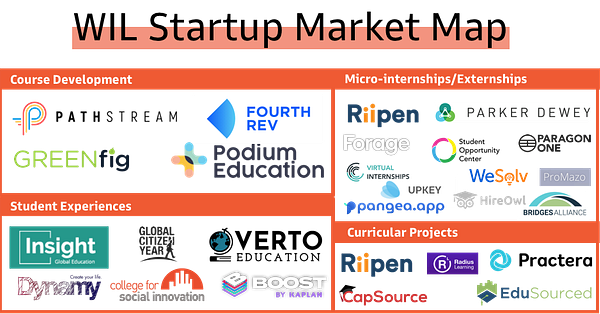Bridging Work and School 🌉 Transcend Newsletter #33
Gaining back the trust of college students + the next Transcend Fellowship!
Hey, Alberto here! Welcome to a very special issue of the Transcend Newsletter.
The Transcend Newsletter explores the future of learning and the future of work, and the founders building it around the world.
Transcend Fellowship - Apply by October 5th
We are on the lookout for 20 early-stage founders to join our Transcend Fellowship – a 4-week remote program to support early-stage founders building the future of learning and work. Fellows who will access the Transcend Network, a founder community 15+ countries, top mentors and operators in the space, events, and more!
🗳Are you a founder in the space? Apply here before October 5th!
Bridging school and work
This newsletter is the result of a joint research effort with Reach Capital on the future of Work-Integrated Learning in US Higher Ed – check out our full report, market map, and slides here. On to the good stuff now!
The higher education context
For decades, “higher education” was synonymous with career advancement. Over 21 million students enrolled in higher education at its peak in 2010.
It’s only been a decade since then, but the story took a drastic turn: only 38% of students who graduated from college in the past decade agree that their higher education was worth the cost. Enrollment is down 6% and projected to further decrease by 15% by 2026.
US Higher education has failed students on two fronts:
Teaching relevant content and skills: only 11% of business leaders “strongly agree” that higher ed institutions are graduating students with the necessary competencies.
Helping students get the right jobs: the top reason for students to go to college is to improve their professional opportunities, yet graduate underemployment is at an all-time high.
For higher ed to deliver on its promise to students, it will need to partner with employers to cover these two key gaps.
Work-Integrated Learning
Work-Integrated Learning (WIL) is a key partnership between employer and universities. It integrates academic learning with practical workforce skills: students get to learn by doing with projects and skills that the employers have brought to them, while still having academic guidance to support the learning.

There’s a strong need for these programs: 70% of career centers today have no industry partnerships in place, even as the number one recommendation from employers to colleges is the inclusion of real-world projects in the academic curriculum.
The WIL Market
WIL Startups effectively act as intermediaries that connect both employers and universities. These two have very different needs, which made it a difficult market for startups… until the pandemic came around.

With COVID, students have become more interested in short-term training programs and direct paths to employment. Universities can’t satisfy all that demand with their existing courses, so they have relied on WIL startups to provide industry-relevant projects to students.

To accommodate all this demand, universities are also creating centralized Experiential Learning centers that can help with the adoption of WIL projects, like the XP Network at Northeastern, University of Central Florida, or the University of Albany, among others.
This has also translated into more activity from WIL startups. We’ve mapped and categorized them into four boxes below:
💻Micro-Internships are short-term professional experiences for students, like Riipen, Forage, or ParkerDewey.
🎒Curricular Projects are employer-driven projects embedded in the academic curriculum for credit, like Rippen or Practera.
🎬Student Experiences are for-credit experiences focused on skill development outside of traditional work environments, such as community service or gap years abroad, like Verto, Insight Global Education, or the College for Social Innovation.
💼Course Development startups create entire skills-focused curricula for higher education, using tools and content sourced directly from tech partners, like Pathstream or FourthRev.


More and more startups are starting to serve this massive demand that COVID and decades of change in higher education have created. To learn more about these trends and opportunities, check out the full report below!
Work-Integrated Learning will be a big part of the future of Higher Education, and if 2020 can get something right, it will be serving as a springboard for these awesome projects.
What did you think? Please leave a comment or reply to this email with you thoughts!

🎓Christine Cruzvergara is a higher ed leader and VP of University Partnerships at Handshake, and she reflected on the unprecedented challenges higher education is facing this fall.
🌱Aditya (S20 Fellow ) and Raj (W20) launched Stoa School to reimagine business education without debt in India.
🔍Fascinating piece on using behavioral science and nudges to guide students towards student success.
🗺Vartika (W20 Fellow) and Stackraft partnered with Hackernoon to help their community get hired!
🌀Don’t forget to apply to the Fall 2020 Transcend Fellowship and share it with friends before applications close on Monday!
📬and 3 newsletters we are following:
cs.ed - thought on technology, learning, and bootcamps
Divinations – business strategy, easily digestible for startup folk
Boundless – thoughts on the future of work

Strategy & Ops Intern - Songbird Therapy
Content Strategist and Writer - Empower Work
Growth Instructor - OnDelta
Operations (Entry-Level) - Edutive
Career Lead / Director of Career - Rivet School
Mission Director: Early Years and Education - Nesta UK
Career Instructor (Part-time Contract) - OnDelta
For more job opportunities, check out our full Job Board!.
Many thanks to the Reach Capital team for the support and insights on this project, and to the founders, higher ed leaders, and students we interviewed!
Thanks for reading another week! If you enjoyed this read, can you tell us what we can do better or what you liked?


